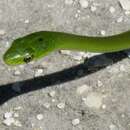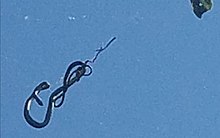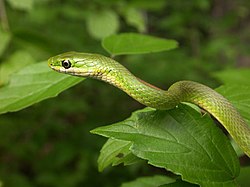ar
الأسماء في صفحات التنقل


There are no known adverse effects of Opheodrys aestivus on humans.
When compared to other snakes, Opheodrys aestivus embryos are well-developed upon egg laying. This allows for a short incubation period outside of the female, thus shortening the span for predators to eat the defenseless eggs. These eggs usually range from 21.4 to 33.6 mm long, 9.3 to 11.1 mm wide, and 1.2 to 2.4 g. Upon hatching, their length averages 128 to 132 mm and weigh 1.1 g (Mitchell, 1994). Most growth occurs in the first year of life. Females grow at a faster pace and reach larger sizes than males. According to Plummer (1985), the growth of rough green snakes follows the Von Bertalanffy model, which allows any size snake to be aged relatively accurately. However, this model is more accurate for younger snakes; error is positively correlated with age.
Rough green snakes are listed as a species of least concern. Due to their apparent population stability, no conservation efforts are planned.
US Federal List: no special status
CITES: no special status
State of Michigan List: no special status
IUCN Red List of Threatened Species: least concern
Rough green snakes use their tongue to sense chemical cues. They also have keen eyesight, allowing them to easily spot movement of prey. Mating behaviors involve tactile and visual cues.
Communication Channels: chemical
Perception Channels: visual ; tactile ; vibrations ; chemical
Although not common pets, domestication of these snakes has become increasingly popular because they are easy to care for.
Positive Impacts: pet trade
Rough green snakes are a source of prey for larger snakes, birds, and other small predators. There are a few known parasites that affect rough green snakes. They are infected occasionally with Cryptosporidium species, which affects the gastrointestinal tract, causing epithelial necrosis.
Commensal/Parasitic Species:
Rough green snakes are insectivores, consuming crickets, grasshoppers, other insects, and spiders (Mitchell, 1994). They exclusively use their extraordinary vision to hunt live prey. Even a slight movement of a leg or antennae is sufficient to draw the attention of these snakes to the location of their prey (Goldsmith, 1986). According to Goldsmith (1986), during the initial phase of their approach, these snakes use fast and irregular movements, but they slow down as they further approach their prey. When rough green snakes are about 3 cm from prey, they assume spring-like curves with their body, followed by a straightening of the body, allowing the snake to propel its head toward the prey, striking either at the head or thorax. Rough green snakes sometimes raise their head above the substrate immediately upon striking in order to get prey away from anything that may aid their escape. Prey is worked further into the mouth and swallowed by movements of the jaw. Prey is usually swallowed head first.
Animal Foods: insects; terrestrial non-insect arthropods
Primary Diet: carnivore (Insectivore )
Opheodrys aestivus, commonly known as the rough green snake, is found widely throughout the southeastern United States. It is found frequently as far north as southern New Jersey and can be found along the East Coast into the Florida Keys. The western range stretches to central Oklahoma, Texas, and into northern Mexico.
Biogeographic Regions: nearctic (Native )
Rough green snakes are typically found on forest edges near ponds or lakes. Although they are arboreal snakes, they forage in dense vegetation along pond and lake shorelines during the day. Their nights are spent coiled in the branches of trees. Rough green snakes choose perches based on distance from shorelines, height in branches, and thickness of the branch. Rough green snakes are most commonly found in deciduous trees, shrubs, hedgerows, and fields.
Habitat Regions: temperate ; terrestrial
Other Habitat Features: riparian
Survival rates are not well known for juvenile rough green snakes. However, adults have low survivorship, which may partly explain why these snakes become sexually mature early and lay rather large clutches annually. The main causes of mortality are environmental factors (hot, dry conditions) and predation. This species has an average life expectancy of 5 years, but they can reach up to 8 years.
Average lifespan
Status: wild: 8 years.
Typical lifespan
Status: wild: 8 (high) years.
Average lifespan
Status: wild: 5 years.
Rough green snakes are small and thin. The dorsal and lateral surfaces are a uniform green, the underbelly, chin and labial scales range from yellowish-green to cream. Males and females have no differences in color or pattern, but females are larger in length and mass, while males have a longer tail length. Juvenile rough green snakes look like smaller adults, except they are lighter in color. Since these snakes are diurnal and tend not to avoid the heat of the day, their peritoneum is black and dense. This is believed to be an adaptation that acts as an ultraviolet radiation shield, keeping these snakes from becoming too hot. Females range from 11 to 54 g in mass, with an average of 26.7 g, males are from 9 to 27 g, with an average of 16.3 g. Average lengths are 947 mm in females and 892 mm in males.
Range mass: female: 11 male: 9 to female: 54 male: 27 g.
Average mass: female: 26.7 male: 16.3 g.
Average length: female: 947 male: 892 mm.
Other Physical Features: heterothermic
Sexual Dimorphism: sexes alike; female larger
Many animals prey up on these snakes, including larger snakes, birds, domestic cats, and even some spiders (Plummer, 1990; Mitchell, 1994). Their only defense mechanism is camouflage.
Known Predators:
Anti-predator Adaptations: cryptic
Rough green snakes reproduce sexually with internal fertilization. These snakes are promiscuous, with males leaving almost immediately after copulation (Richmond, 1956). Courtship behavior of rough green snakes consists of visual orientation of males towards females, approach, body contact, and body alignment. Some motor patterns that are displayed during these stages are dorsal crawling, chin rubbing, tail waving, and head jerking. Once aligned with a female, a male begins with tail search copulatory attempts in energetic spurts followed by periods of motionlessness. On average, alignment is accomplished in about 2:45 minutes and the copulatory sequences average about 16:04 minutes (Goldsmith, 1988).
Mating System: polygynandrous (promiscuous)
Rough green snakes reach sexual maturity at 21 months in males and 21 to 33 months in females (Plummer, 1985). Although they breed every spring, fall matings have been noted (Mitchell, 1994). The gestation period can range from 5 to 12 weeks, depending on temperatures, and they typically lay their eggs during June and July (Plummer, 1990). Clutch size is 3 to 12 soft-shelled eggs (Mitchell, 1994). Males first breed in the spring of their second year, usually around 21 months. However only half of females participate in breeding during their second spring, while the other half delays an additional 12 months. Reproductively mature females can range from 360 to 400 mm snout-vent length, while sexually-mature males average 300 mm (Plummer, 1985).
Breeding interval: Breeding occurs once yearly.
Breeding season: Rough green snakes breed in the spring.
Range number of offspring: 3 to 12.
Average number of offspring: 6.2.
Range gestation period: 5 to 12 weeks.
Average gestation period: 6 weeks.
Range age at sexual or reproductive maturity (female): 21 to 33 months.
Range age at sexual or reproductive maturity (male): 20 to 21 months.
Average age at sexual or reproductive maturity (male): 21 months.
Key Reproductive Features: iteroparous ; seasonal breeding ; sexual ; oviparous
Female rough green snakes nearing oviposition leave their usual arboreal habitat to travel on the ground away from the shoreline. They seek out hollows in dead or living trees, decaying logs, under rocks or under boards in sandy soil. Such areas provide sufficient moisture levels for egg-laying. These locations are usually about 30.0 m (+/- 9.0 m) away from the shoreline. After oviposition, females return to the shoreline and resume her arboreal post. Females have no further contact with their eggs after hatching (Plummer, 1990).
Parental Investment: no parental involvement; pre-fertilization (Protecting: Female); pre-hatching/birth (Provisioning: Female, Protecting: Female)
The Rough Green Snake is an excellent climber, often foraging amid vines and shrubs, its green body blending in with the surrounding vegetation (Conant and Collins 1991). It is active during the day (Behler and King 1979).
The Rough Green Snake (Opheodrys aestivus) is a slender, green, semi-arboreal snake of the southeastern United States and northeastern Mexico (Behler and King 1979; Conant and Collins 1991).
The Rough Green Snake is found from southern New Jersey to the Florida Keys; west to southeastern Kansas and Texas; and south in Mexico to Tampico, with an isolated population in Coahuila (Conant and Collins 1991).
The Rough Green Snake is sometimes almost semi-aquatic, often occuring in the dense overgrowth along streams or lakes and freely entering shallow water (Conant and Collins 1991). It may be found from sea level to 1,500 m (Behler and King 1979).
In the United States, the distribution of the Rough Green Snake is largely non-overlapping with the distinctly more northern distribution of the very similar Smooth Green Snake (Opheodrys vernalis). The Rough Green Snake is more slender, grows to a much greater length, and has keeled scales (Smooth Green Snake scales are smooth, as are those of the greenish Mexican Racer, Coluber constrictor oaxaca). In terms of habit, the Rough Green Snake is more arboreal and the Smooth Green Snake more terrestrial. (Conant and Collins 1991).
The Rough Green Snake is 56 to 81 cm long (record 116 cm). It is a slender snake, plain light green above and plain white, yellow, or pale greenish below. (After death, the bright green coloration quickly fades to blue, a point to keep in mind if encountering a dull blue road-killed snake.) The scales (in 17 rows, Behler and King 1979) are keeled and the anal plate is divided. Young are grayish green and 17 to 23 cm long at hatching. (Conant and Collins 1991)
Rough Green Snake mating occurs in spring and fall. The female lays 3 to 12 smooth, rather hard, capsule-shaped eggs, 28 mm long. Young hatch in 5 to 12 weeks and mature in 1 to 2 years. (Behler and King 1979)
The bulk of the Rough Green Snake's diet consists of crickets, grasshoppers, caterpillars, and spiders (Conant and Collins 1991).
Opheodrys aestivus, commonly known as the rough green snake, is a nonvenomous North American colubrid. It is sometimes called grass snake or green grass snake, but these names are more commonly applied to the smooth green snake (Opheodrys vernalis). The European colubrid called grass snake (Natrix natrix) is unrelated. The rough green snake is docile, often allowing close approach by humans, and seldom bites. Even when bites occur, they have no venom and are harmless.
The rough green snake (Opheodrys aestivus) is bright green above and has a yellowish belly, affording it excellent camouflage in green vegetation and making them difficult to see in the wild even though they are relatively common in their habitat. It has keeled dorsal scales, which are arranged in 17 rows at mid-body. It grows up to 116 cm (45+3⁄4 in) in total length (including tail)[4] and is very thin.
The rough green snake ranges throughout the Southeastern United States, from Florida, north to coastal Maine, Indiana, and west to Central Texas. The snake is commonly found in the Piedmont and Atlantic coastal plain, but is not found in the higher elevations of the Appalachian Mountains. It is also found in northeastern Mexico, including the state of Tamaulipas and eastern Nuevo León.
The preferred habitat of O. aestivus is moist meadows and woodlands, often near water. It is highly arboreal, frequently found climbing in low vegetation, and is also a good swimmer. However, it is often found on the ground as well. Unlike many snakes, it is largely diurnal. At night it is found coiled in the branches of trees. Preference is given to perches based upon distance from the shoreline, height of branches, and thickness of the individual branch.[5]
The diet of O. aestivus consists mostly of insects and other terrestrial arthropods, but some snails and tree frogs are eaten as well. This snake is not a constrictor; most prey are grabbed and simply swallowed alive. O. aestivus has been shown to rely heavily on visual cues for prey detection and to prefer living prey items.[6] As foraging activity increases, the tongue evolves greater elongation and deeper forking, and the abundance of chemoreceptors increases in the vomeronasal organs, the chemosenory responsiveness is adjusted to match diet and orthopterans constitute 16.9% and all arthropods about 98% of dietary volume of the rough green snake.[7] Rough green snakes exhibit greater chemosensory investigation of chemical cues from their insect prey than from representatives of several other taxa because of the linked importance of insects to their diet.[7]

Predators of the rough green snake include birds and other snakes, such as the eastern racer (Coluber constrictor) and the eastern king snake (Lampropeltis getula). They can also be infected by parasites including the Cryptosporidium species. [8] The rough green snake also does not exhibit any predator-resistance capabilities besides fleeing. They often undergo a lot of stress due to human presence.
The male rough green snake reaches sexual maturity at an age of 2 around 245 mm long. The females of the rough green snake reach sexual maturity around 1-2 years of age, or when they reach between 350-400 mm in length. [9]For the male, plasma androgen levels and the diameter of the sexual segment of the kidney have a bimodal cycle with one peak in the spring and the second in late summer.[10] Spermatogenesis occurs in June, reaching its peak in July and August. This is a post-nupital cycle.[10] The rough green snake breeds in spring, and sometimes again in fall. Courtship behavior expressed by males include head-jerking, tail waving, and chin-rubbing. Males align copulatory organs with females in an average of 2 minutes and 45 seconds, and copulation averages 16 minutes and 4 seconds.[11] Females lay 2-14 eggs, occasionally in a communal nest shared by more than one female. Up to 75 eggs have been found in one such nest. The nest site varies: under boards, under bark in rotting stumps, in deep mulch, or under a rock. Hatchlings from spring breeding typically emerge in August or September, and each is about 18–20 cm (7.1–7.9 in) in total length. Male rough green snakes reach sexual maturity in two years. At maturity, males begin storing abundant amounts of sperm in their vas deferens. They are able to mate in the spring of the next year (year 3 of life).[10]
The rough green snake is widespread and is not of conservation concern, in general. However, urban development, especially the reduction of vegetation near waterways, may reduce their numbers. Many are killed on roads, and they may be susceptible to poisoning by pesticides used on their insect prey. When dead, they turn blue. It is also one of the most exploited pet snakes in North America. O. aestivus are collected by the hundreds each year.
Opheodrys aestivus, commonly known as the rough green snake, is a nonvenomous North American colubrid. It is sometimes called grass snake or green grass snake, but these names are more commonly applied to the smooth green snake (Opheodrys vernalis). The European colubrid called grass snake (Natrix natrix) is unrelated. The rough green snake is docile, often allowing close approach by humans, and seldom bites. Even when bites occur, they have no venom and are harmless.
Opheodrys aestivus Opheodrys generoko animalia da. Narrastien barruko Colubridae familian sailkatuta dago.
Opheodrys aestivus Opheodrys generoko animalia da. Narrastien barruko Colubridae familian sailkatuta dago.
Opheodrys aestivus est une espèce de serpents de la famille des Colubridae[1].
Cette espèce se rencontre[1] :
Ce serpent est vert sur le dessus, et jaune dessous. Il atteint environ 100 centimètres et est d'aspect très fin. Il vit dans des zones plutôt humides, boisées, et est principalement diurne. Il est carnivore et consomme divers insectes et arthropodes, et éventuellement des escargots et de petits amphibiens.
Ce reptile se reproduit au printemps, Les femelles pondent de 3 à 12 œufs, en utilisant parfois des sites de ponte communautaires. Les petits éclosent en général en août et septembre, et mesurent environ 20 centimètres à la naissance.
Selon Reptarium Reptile Database (19 février 2014)[2] :
Opheodrys aestivus est une espèce de serpents de la famille des Colubridae.
Wąż trawny (Opheodrys aestivus) – gatunek niejadowitego węża z rodziny połozowatych (Colubridae). Ma zielone ubarwienie ciała, żółto-biały spód. Doskonale wtapia się w otoczenie. Głowa jest owalna, ciało smukłe, ogon długi.
Gatunek ten występuje w południowo-wschodniej części Stanów Zjednoczonych. Można go spotkać w lasach i zakrzewieniach. Często spotykany też w ogrodach.
Wąż ten świetnie wspina się na drzewa. Ma bardzo spokojne usposobienie i nie jest płochliwy. Nie jest jadowity.
 Alethinophidia
Alethinophidia Wąż trawny (Opheodrys aestivus) – gatunek niejadowitego węża z rodziny połozowatych (Colubridae). Ma zielone ubarwienie ciała, żółto-biały spód. Doskonale wtapia się w otoczenie. Głowa jest owalna, ciało smukłe, ogon długi.
Opheodrys aestivus là một loài rắn trong họ Rắn nước. Loài này được Linnaeus mô tả khoa học đầu tiên năm 1766.[3]
Opheodrys aestivus là một loài rắn trong họ Rắn nước. Loài này được Linnaeus mô tả khoa học đầu tiên năm 1766.

 分類 界 : 動物界 Animalia 門 : 脊索動物門 Chordata 亜門 : 脊椎動物亜門 Vertebrata 綱 : 爬虫綱 Reptilia 目 : 有鱗目 Squamata 亜目 : ヘビ亜目 Serpentes 科 : ナミヘビ科 Colubridae 属 : アメリカアオヘビ属 Opheodrys 種 : ラフアオヘビ O. aestivus 学名 Opheodrys aestivus
分類 界 : 動物界 Animalia 門 : 脊索動物門 Chordata 亜門 : 脊椎動物亜門 Vertebrata 綱 : 爬虫綱 Reptilia 目 : 有鱗目 Squamata 亜目 : ヘビ亜目 Serpentes 科 : ナミヘビ科 Colubridae 属 : アメリカアオヘビ属 Opheodrys 種 : ラフアオヘビ O. aestivus 学名 Opheodrys aestivusラフアオヘビ(学名:Opheodrys aestivus)は、ナミヘビ科アメリカアオヘビ属に分類されるヘビ。
全長60-80cm。体形は細長い。背面は緑色、腹面は白や淡黄色。鱗に筋状の隆起(キール)がある(手触りが粗い)ことが和名や英名の由来。
眼は大型で、虹彩は丸い。
幼蛇は体色が灰色がかる。
繁殖形態は卵生で、1回に4個の卵を産む。
ペットとして飼育されることもあり、日本にも輸入されている。ペットとして飼育されるヘビの主な餌であるマウスやラットに抵抗がある人向けのヘビとして紹介されることもある。しかし食事の間隔が短い、昼行性のため日光浴もしくはそれに代わる照明器具が必要、全長の割に広い飼育スペースがないと調子を崩しやすい等と飼育の易しい種ではないとされる。